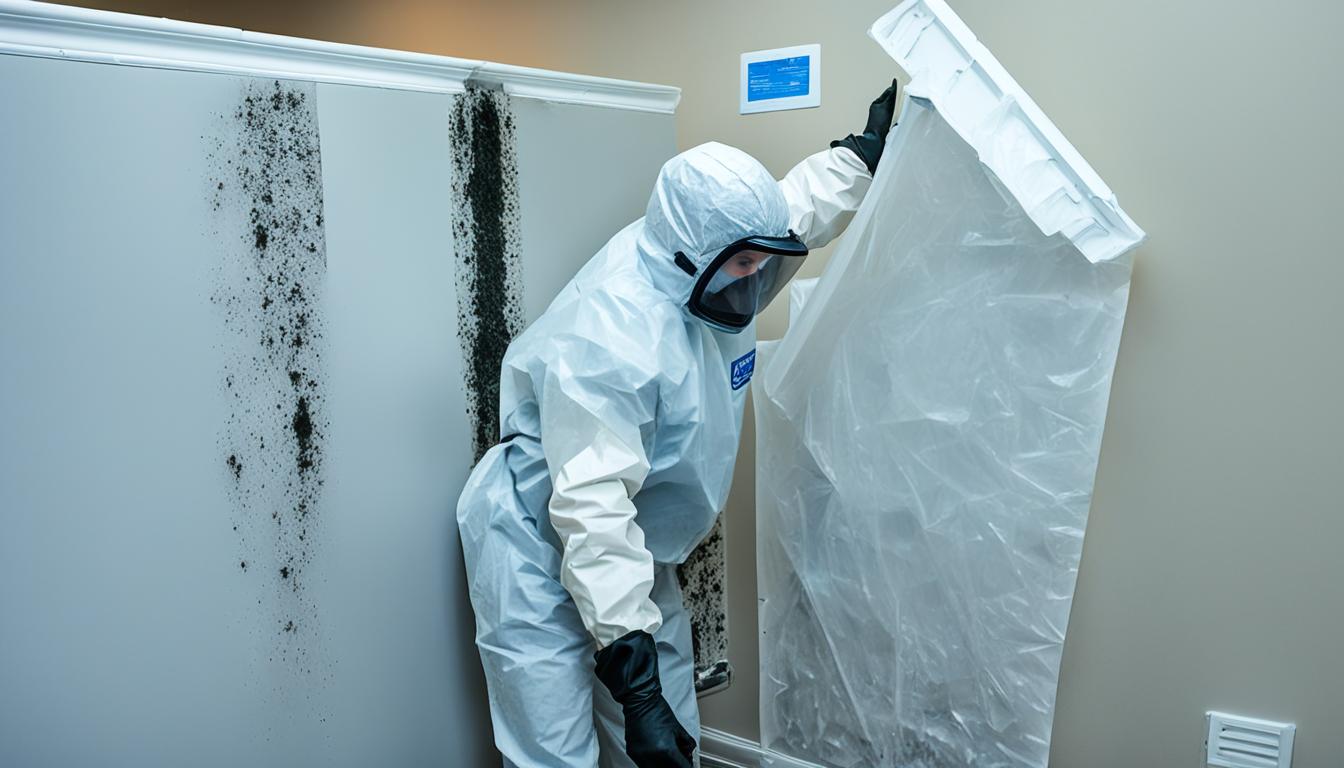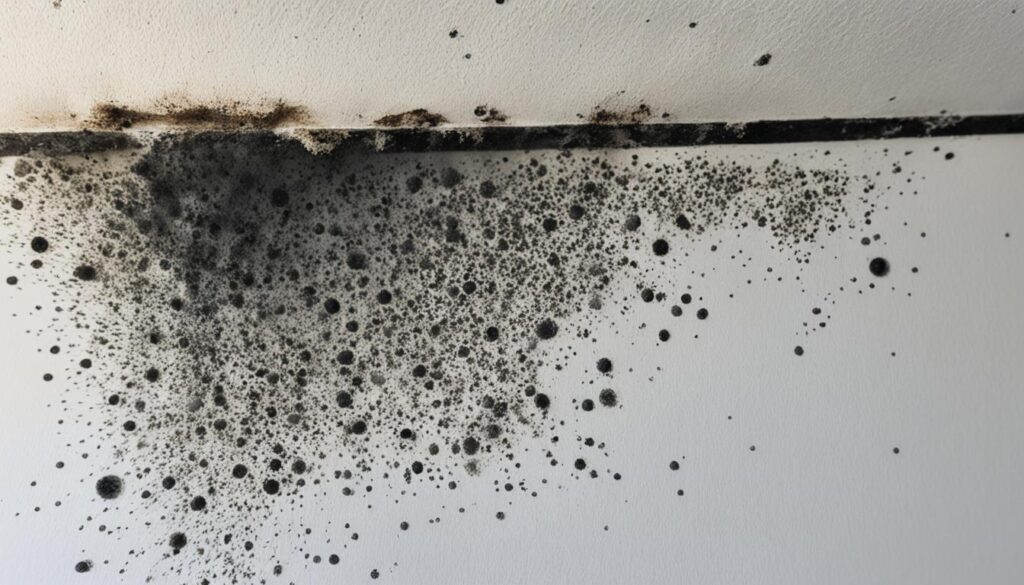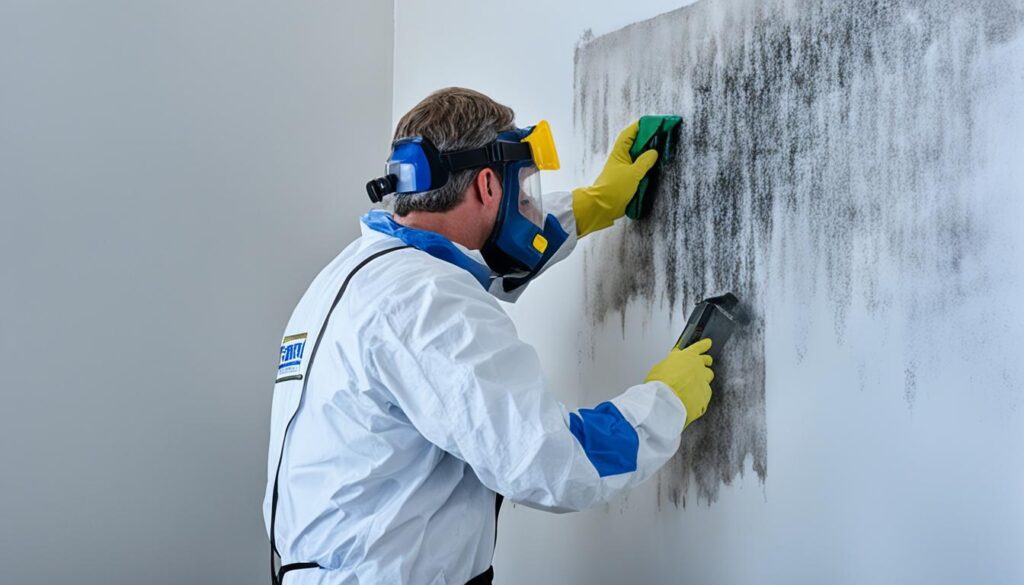
Safe Black Mold Removal from Drywall Guide
Black mold is not only unsightly but also poses a significant threat to your health and the structural integrity of your home. If you’ve discovered black mold on your drywall, it is crucial to address this issue promptly and efficiently. In this comprehensive guide, we will walk you through the safe and effective methods for removing black mold from drywall, ensuring a clean and healthy living environment.
Key Takeaways:
- Black mold on drywall can be a health hazard and cause damage to your home.
- Prompt action is crucial to prevent further damage and mitigate potential health risks.
- Understanding the dangers associated with black mold on drywall is essential.
- There are safe and effective methods for removing black mold from drywall.
- Professional help should be sought when necessary.
Understanding the Dangers of Black Mold on Drywall
Before delving into the removal process, it is crucial to understand the potential dangers associated with black mold on drywall. Black mold, scientifically known as Stachybotrys chartarum, can pose serious health risks and cause structural concerns when present on drywall. Immediate remediation is essential to mitigate these risks and protect your home.
Health Risks:
The presence of black mold on drywall can lead to various health issues, particularly for individuals with respiratory problems, allergies, or weakened immune systems. Exposure to mold spores can trigger allergic reactions, such as coughing, sneezing, and respiratory irritation. Prolonged exposure or ingestion of mold can also cause more severe symptoms, including headaches, fatigue, dizziness, and even respiratory infections.
Structural Concerns:
In addition to the health risks, black mold growth on drywall can compromise the structural integrity of your home. As mold colonies thrive, they penetrate the porous surface of drywall, causing discoloration, deterioration, and weakening of the material. Over time, this can lead to structural damage, such as sagging or crumbling walls, which may require costly repairs.
“Black mold on drywall not only poses health risks but also jeopardizes the stability of your home. Promptly addressing any mold growth is crucial to prevent further damage and ensure the safety of your living environment.”
Preventing Further Damage
To prevent further damage caused by black mold on drywall, it is important to address the issue as soon as possible. Proper remediation techniques and preventive measures should be implemented to minimize the spread of mold spores and inhibit future mold growth.
Removing black mold from drywall involves a systematic approach that includes identifying the source of moisture, isolating the affected area, removing and disposing of contaminated materials, thorough cleaning, and implementing appropriate preventive measures.
By understanding the dangers associated with black mold on drywall and taking prompt action, you can protect your health and safeguard your home from potential structural damage.

| Health Risks | Structural Concerns |
|---|---|
| Respiratory irritation | Discoloration of drywall |
| Allergic reactions | Deterioration of drywall |
| Headaches and fatigue | Weakening of drywall |
| Respiratory infections | Structural damage |
Safe and Effective Methods for Removing Black Mold from Drywall
When it comes to removing black mold from drywall, it is essential to follow safe and effective methods to ensure thorough remediation. Taking the right precautions and using suitable cleaning solutions will not only address the mold issue but also protect your health and prevent further damage. In this section, we will provide step-by-step instructions on how to safely remove black mold from drywall.
Preparation and Containment
Before you begin the removal process, it is crucial to take the necessary precautions to minimize the spread of mold spores. Follow these steps for proper preparation and containment:
- Wear protective gear, including gloves, goggles, and a mask, to prevent direct contact with the mold and inhalation of spores.
- Seal off the affected area by covering vents, doorways, and any openings with plastic sheets or tape to prevent mold spores from spreading to other parts of the house.
- Open windows and use fans to create proper ventilation.
- Remove any furniture or items from the affected area to reduce the risk of contamination.
Cleaning Solutions
Choosing the right cleaning solutions is crucial for effectively removing black mold from drywall. Here are some safe and effective options:
- Vinegar: A natural and inexpensive option, vinegar can effectively kill mold. Mix equal parts vinegar and water in a spray bottle and apply it to the moldy area. Let it sit for an hour, then scrub the surface with a brush and wipe clean.
- Bleach: Although it is a powerful mold killer, bleach should be used with caution. Mix one cup of bleach with one gallon of water and apply it to the affected area. Let it sit for 15 minutes, then scrub and rinse thoroughly.
- Hydrogen Peroxide: This non-toxic alternative can effectively kill mold on porous surfaces. Apply 3% hydrogen peroxide to the moldy area, let it sit for 10 minutes, scrub, and rinse with water.
- Borax: A natural mineral, borax can eliminate mold and inhibit its future growth. Mix one cup of borax with one gallon of water and apply it to the moldy surface. Scrub the area thoroughly and let it dry.
Disposal and Prevention
After completing the mold removal process, it is crucial to dispose of the materials properly and take preventive measures to avoid future mold growth. Follow these steps:
- Double-bag all the materials used during the removal process, including gloves, sponges, and cleaning cloths.
- Seal the bags tightly and dispose of them in accordance with local regulations.
- Monitor the area for any signs of mold regrowth and address any moisture issues promptly.
- Implement preventive measures such as proper ventilation, controlling humidity levels, and fixing any leaks or water damage in your home.
By following these safe and effective methods, you can successfully remove black mold from drywall, ensuring a healthy environment for you and your family.

| Safe and Effective Methods | Pros | Cons |
|---|---|---|
| Vinegar | – Natural and inexpensive – Non-toxic – Kills mold effectively |
– Strong odor – May not be as effective on porous surfaces |
| Bleach | – Powerful mold killer – Affordable and readily available |
– Harsh fumes – Can damage certain surfaces – Requires careful handling |
| Hydrogen Peroxide | – Non-toxic – Effective on porous surfaces – Can inhibit future mold growth |
– May not be as effective on non-porous surfaces |
| Borax | – Natural – Inhibits future mold growth – Can penetrate porous surfaces |
– Can be abrasive to some materials – Requires thorough rinsing |
Conclusion
In conclusion, the safe removal of black mold from drywall is crucial to ensure the protection of your home and the well-being of its occupants. Black mold can pose significant health risks and cause structural damage if left unattended. However, by understanding the dangers associated with black mold, implementing the safe and effective removal methods discussed in this guide, and seeking professional assistance when needed, you can successfully eliminate black mold from your drywall.
Remember that taking prompt action is vital to prevent further damage and mitigate potential health risks. By promptly addressing any signs of black mold growth on your drywall and following the prescribed removal procedures, you can safeguard the structural integrity of your home and protect yourself and your loved ones from health complications. It is always recommended to prioritize safety and follow the outlined steps diligently to ensure a thorough and successful mold removal process.
By carefully following the instructions to prepare the affected area, using appropriate cleaning solutions, and donning protective gear, you can effectively remove black mold from your drywall while minimizing the risk of exposing yourself to harmful mold spores. However, if you are unsure or uncomfortable with the removal process, it is advisable to seek professional help. Mold remediation experts have the knowledge, experience, and specialized equipment to handle black mold removal safely and effectively.
In summary, tackling the issue of black mold on drywall requires diligence, caution, and immediate action. By understanding the dangers, employing safe and effective removal methods, and enlisting professional assistance when necessary, you can successfully eliminate black mold and create a safe and healthy environment in your home.




